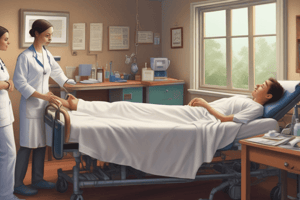Podcast
Questions and Answers
What is the definition of a near miss in the context of patient safety?
What is the definition of a near miss in the context of patient safety?
- An error in the computerized prescriber order entry system
- An event that goes unnoticed by healthcare staff
- An event that causes patient injury due to chance
- An event or situation that did not produce patient injury, but only because of chance (correct)
How can errors be minimized through computerized prescriber order entry?
How can errors be minimized through computerized prescriber order entry?
- By performing 3 checks and 2 identifiers
- By asking for sound alike medications to be put in nearby bins
- By not having to read a physician's handwriting (correct)
- By using automated dispensing machines
What does T.A.C.I.T. stand for in the context of medication safety?
What does T.A.C.I.T. stand for in the context of medication safety?
- Treatment, Allergies, Contraindications, Interactions, Toxicity
- Therapeutic effect, Allergies, Contraindications, Interactions, Toxicity/Overdose (correct)
- Total Assessment of Clinical Injuries and Treatments
- Technical Aspects of Clinical Information Technology
What is the recommended approach for getting a telephone order for medication?
What is the recommended approach for getting a telephone order for medication?
In the context of medication administration, why should zeros never be put at the end of a decimal in the medication order?
In the context of medication administration, why should zeros never be put at the end of a decimal in the medication order?
What is the significance of ensuring that all 'the rights' are in place when taking an order from a provider?
What is the significance of ensuring that all 'the rights' are in place when taking an order from a provider?
1 mg is ________ micrograms
1 mg is ________ micrograms
Always listen to medication concerns raised by your patient
Always listen to medication concerns raised by your patient
Match
Match
If you can't scan the medication, you can still give it to the patient if they can give you the two identifiers
If you can't scan the medication, you can still give it to the patient if they can give you the two identifiers
If you did not draw up or prepare the medication yourself, don't give it to the patient.
If you did not draw up or prepare the medication yourself, don't give it to the patient.
Flashcards are hidden until you start studying
Study Notes
Patient Safety and Medication Administration
Near Misses
- Definition: A near miss is an event that has the potential to cause harm but does not, either by chance or through timely intervention.
Minimizing Errors through Computerized Prescriber Order Entry
- Errors can be minimized by using computerized prescriber order entry, which helps reduce medication errors, improves legibility, and checks for potential drug interactions and allergic reactions.
T.A.C.I.T. in Medication Safety
- T.A.C.I.T. stands for Taking Adverse drug reactions Seriously, Conducting regular reviews, Implementing safety initiatives, Coordinating patient care, Investigating errors, and Taking responsibility.
Telephone Orders for Medication
- Recommended approach: Verify the order with the provider, confirm the order with the pharmacist, and have the provider confirm the order is correct.
Medication Administration Safety
- Zeros should never be added to the end of a decimal in a medication order to avoid dosing errors.
The Rights of Medication Administration
- Ensuring all 'the rights' are in place when taking an order from a provider: right patient, right medication, right dose, right time, right route, and right documentation.
Medication Conversions
- 1 mg is equivalent to 1,000 micrograms.
Patient Communication
- Always listen to medication concerns raised by your patient.
Medication Scanning and Verification
- If you can't scan the medication, verify the medication with two identifiers before administering it to the patient.
- If you did not draw up or prepare the medication yourself, do not give it to the patient.
Studying That Suits You
Use AI to generate personalized quizzes and flashcards to suit your learning preferences.




